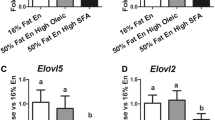Abstract
The fatty acid composition of diacyl- and alkylacylglycerophosphocholine (PC), phosphatidylinositol (PI), phosphatidylserine (PS), alkenylacyl-glycerophosphoethanolamine (aPE), and diacyl- and alkylacyl-glycerophosphoethanolamine (dPE) was assessed in isolated splenocytes from C3H/Hen mice fed one of four purified isocaloric diets for six weeks. Diets contained 20% by weight of either a high-linoleate sunflower oil (Hi 18∶2), a high-oleate sunflower oil (Hi 18∶1), a mixture of 17% menhaden fish oil and 3% high-linoleate sunflower oil (Hi n−3), or a mixture of 17% coconut oil and 3% high-linoleate sunflower oil (Hi SFA). Spleen weight and immune cell yield were significantly higher (P<0.05) in mice fed the Hi 18∶1 or the Hi n−3 diets compared with those fed the Hi 18∶2 and Hi SFA diets. Distinctive patterns of fatty acids were observed for each phospholipid in response to dietary fatty acids. Dietary fat significantly affected (P<0.05) total polyunsaturated fatty acids (PUFA) in PC and dPE, total saturated fatty acids (SFA) in PC, total monounsaturated fatty acids (MUFA), and n−3 PUFA in all phospholipid classes examined. In mice fed the Hi n−3 diet, n−3 PUFA were significantly elevated, whereas n−6 PUFA decreased in all of the phospholipids. In these mice, eicosapentaenoic acid (EPA) was the predominant n−3 PUFA in PC and PI, whereas docosahexaenoic acid (DHA) was the major n−3 PUFA in aPE and PS. Interestingly, the ratios of n−3/n−6 PUFA in the phospholipids from these mice were 3.2, 2.4, 1.8, 0.8 and 0.8 for aPE, PS, dPE, PC and PI, respectively. These data suggest a preferential incorporation of n−3 PUFA into aPE, PS and dPE over PC and PI.
Similar content being viewed by others
Abbreviations
- AA:
-
arachidonic acid
- DHA:
-
docosahexaenoic acid
- DPA:
-
docosapentaenoic acid
- EPA:
-
eicosapentaenoic acid
- FAME:
-
fatty acid methyl esters
- GC:
-
gas chromatography
- Hi 18∶1:
-
higholeate sunflower oil
- Hi 18∶2:
-
high-linoleate sunflower oil
- Hi n−3:
-
a mixture of 17% menhaden fish oil and 3% high-linoleate sunflower oil
- Hi SFA:
-
a mixture of 17% coconut oil and 3% high-linoleate sunflower oil
- HPTLC:
-
high-performance thin-layer chromatography
- MUFA:
-
monounsaturated fatty acids
- PC:
-
diacyl- and alkylacylglycerophosphocholine
- aPE:
-
alkenylacyl-glycerophosphoethanolamine
- dPE:
-
diacyl- and alkylacyl-glycerophosphoethanolamine
- PI:
-
phosphatidylinositol
- PMN:
-
polymorphonuclear leukocytes
- PS:
-
phosphatidylserine
- PUFA:
-
polyunsaturated fatty acids
- SFA:
-
saturated fatty acids
- TLC:
-
thin-layer chromatography
References
King, M.E., and Spector, A.A. (1978)J. Biol. Chem. 253, 6493–6501.
Stubbs, C.D., and Smith, A.D. (1984)Biochim. Biophys. Acta 779, 89–137.
Neelands, P.J., and Clandinin, M.T. (1983)Biochem. J. 212, 573–583.
Alam, S.Q., Alam, B.S., and Ren, Y.-F. (1987)J. Mol. Cell. Cardiol. 19, 465–475.
Surette, M.E., Croset, M., Lokesh, B.R., and Kinsella, J.E. (1990)Nutr. Res. 10, 211–218.
Laposata, M., Kaiser, S.L., and Capriotti, A.M. (1988)J. Biol. Chem. 263, 3266–3273.
Yeo, Y.K., Philbrick, D.-J., and Holub, B.J. (1989)Biochem. Biophys. Res. Commun. 160, 1238–1242.
Rola-Pleszczynski, M. (1990) inPlatelet-Activating Factor in Endotoxin and Immune Diseases (Handley, D.A., Saunders, R.N., Houlihan, W., and Tomesch, J.C., eds.) pp. 275–284. Marcel Dekker, New York.
Henderson, C.D., Black, H.S., and Wolf, Jr., J.E. (1989)Lipids 24, 502–505.
Croft, K.D., Sturm, M.J., Codde, J.P., Vandongen, R., and Beilin, L.J. (1986)Life Sci. 38, 1875–1882.
Marshall, L.A., and Johnston, P.V. (1985)J. Nutr. 115, 1572–1578.
Johnston, P.V. (1985)Adv. Lipid Res. 22, 257–287.
Erickson, K.L., Adams, D.A., and McNeill, C.J. (1983)Lipids 18, 468–474.
DeWille, J.W., Fraker, P.J., and Romsos, D.R. (1979)J. Nutr. 109, 1018–1027.
Lokesh, B.R., Hsieh, H.L., and Kinsella, J.E. (1986)Ann. Nutr. Metab. 30, 357–364.
Careaga-Houck, M., and Sprecher, H.W. (1989)J. Lipid Res., 30, 77–87.
Berger, A., and German, B. (1990)Lipids 25, 473–480.
Chapkin, R.S., and Carmichael, S.L. (1990)Lipids 25, 827–834.
American Institute of Nutrition (1980)J. Nutr. 110, 1726.
Sun, G.Y. (1988) inLipids and Related Compounds (Boulton, A.A., Baker, G.B., and Horrocks, L.A., eds.), pp. 63–82. The Humana Press, Inc. Clifton.
Cinader, B., Clandinin, M.T., Hosokawa, T., and Robblee, N.M. (1983)Immunol. Lett. 6, 331–337.
Marshall, L.A., and Johnston, P.V. (1983)Lipids 18, 737–742.
Conroy, D.M., Stubbs, C.D., Belin, J., Pryor, C.L. and Smith, A.D. (1986)Biochim. Biophys. Acta 861, 457–462.
Cleland, L.G., Gibson, R.A., Hawkes, J.S., and James, M.J. (1990)Lipids 25, 559–564.
Furth, E.E., Hurtubise, V., Schott, M.A., and Laposata, M. (1989)J. Biol. Chem. 264, 18494–18501.
Anderson, R.E. (1970)Exptl. Eye Res. 10, 339–344.
Poovaiah, B.P.O., Tinoco, J., and Lyman, R.L. (1976)Lipids 11, 194–202.
Aukema, H.M., and Holub, B.J. (1989)J. Lipid Res. 30, 59–64.
Fritsche, K.L., and Johnston, P.V. (1990)Nutr. Res. 10, 577–588.
Novo, C., Fonseca, E., and Frietas, A.A. (1987)Cell. Immunol. 106, 387–396.
Chapkin, R.S., and Coble, K.J. (1991)J. Nutr. Biochem. 2, 158–164.
Author information
Authors and Affiliations
About this article
Cite this article
Huang, SC., Fritsche, K.L. Alteration in mouse splenic phospholipid fatty acid composition and lymphoid cell populations by dietary fat. Lipids 27, 25–32 (1992). https://doi.org/10.1007/BF02537054
Received:
Revised:
Accepted:
Issue Date:
DOI: https://doi.org/10.1007/BF02537054




